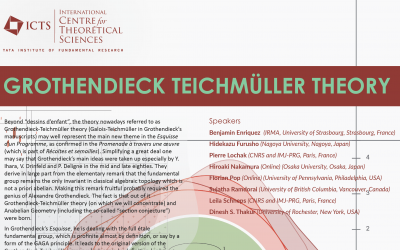Beyond “dessins d’enfant”, the theory nowadays referred to as Grothendieck-Teichmüller theory (Galois-Teichmüller in Grothendieck’s manuscripts) may well represent the main new theme in the Esquisse d'un Programme, as confirmed in the Promenade à travers une œuvre (which is part of Récoltes et semailles). Simplifying a great deal one may say that Grothendieck’s main ideas were taken up especially by Y. Ihara, V. Drinfeld and P. Deligne in the mid and late eighties.They derive in large part from the elementary remark that the fundamental group remains the only invariant in classical algebraic topology which is not a priori abelian .Making this remark fruitful probably required the genius of Alexandre Grothendieck . The fact is that out of it Grothendieck-Teichmüller theory (on which we will concentrate) and Anabelian Geometry (including the so-called “section conjecture”) were born.
In Grothendieck’s Esquisse, he is dealing with the full étale fundamental group, which is profinite almost by definition, or say by a form of the GAGA principle. It leads to the original version of the Grothendieck-Teichmüller group which again by definition (or by functoriality) and using the famous Belyi theorem, contains the absolute Galois group Gal(Q) of the field Q (the prime field in charateristic zero, as Grothendieck likes to put it).A significant bifurcation occurred in Deligne’s 1989 paper on Le groupe fondamental de la droite projective moins trois points,in which the author brings in the rich toolbox of rational homotopy theory and motives (at least what we nowadays call mixed Tate motives),at the expense of using the prounipotent (not profinite) fundamental group. The ensuing version of the Grothendieck-Teichmüller group of course does not contain the Galois group anymore but this linearized version of the theory lends itself more easily to computations (e.g. those involving Multiple Zeta Values) and has become largely prevalent (including lately in deformation theory).
In this week long meeting we will discuss both versions (which could also be termed “linear” and “nonlinear”), including in particular an introduction to the profinite (nonlinear) version of the theory, which seems much closer to what Grothendieck initially had in mind and has been hitherto much less publicized. There will be mini-courses by subject experts of introductory nature for younger researchers, who were not exposed to these topics before.There will also be a few research talks by active researchers to explain the current state of the art in the subject of the meeting.
Accommodation will be provided for outstation participants at our on campus guest house.
ICTS is committed to building an environment that is inclusive, non discriminatory and welcoming of diverse individuals. We especially encourage the participation of women and other under-represented groups.
Eligibility Criteria: Senior Ph.D. students, postdocs, and faculties working on topics related to the theme of the meeting.
 theory
theory  icts
icts res
res in
in

